
Do I Need to Stretch Before Playing Table Tennis?
Stretching is the part of a workout or training session that is often overlooked. Maybe by now, professional athletes have already learned the significance of developing and performing this routine.
However, there are still some that would rush into their workout thinking that it is a smarter way of utilizing their time since stretching will not burn as much calorie anyway. What they do not realize is that proper stretching is fundamental and it can either make or break their workout.
Why Stretch?
There are only two things that athletes have to be remember to convince themselves that stretching the muscles before and after a training session is important and not to mention, crucial. First, it helps improve one’s game as it warms the body and allows it to perform at its highest level and secondly, it prevents one from suffering injury as it helps not just the muscles but also the joints to reach their maximum range of motion or flexibility making them accustomed to the kind of intensity and tension that will occur throughout the workout activity.
There are different kinds of stretching and each kind provides specific assistance to the muscles and joints of the body. In this article, we will go over the kind that is incorporated in the warm up routine before an activity which is the dynamic stretching and also the one that is performed to cool down and relax the body after an activity which is the static stretching.
Dynamic Stretching
What is dynamic stretching?
We all know how rubber bands work, right? And we are also aware that when they are left unused for a long period of time, they dry up and become brittle causing them to break into pieces in an attempt to put them into use once again.
Muscles are like rubber bands. When they are sedentary for a certain period of time, they tend to become less “elastic” and less flexible. This is the reason why when you start working out and engaging in physical activities after not being active for a while, your muscles become sore and the tendency of suffering injuries is always there.
So what do people who are engaged in physical activities do before they proceed with their routine? They perform dynamic stretching exercises. As the name suggests, dynamic stretching involves incorporating active and constant movements to the stretching routine to help activate the muscles that will be used throughout the workout session. This kind of stretching is done to warm up muscles and stimulate body mechanisms necessary for the work to be done.
What are the benefits of dynamic stretching?
Both dynamic and static stretching exercises help loosen up muscles and prevent muscle strain injuries. However, what sets dynamic stretching apart from static stretching is that it helps the body prepare in a sport-specific manner. There are a number of specific dynamic stretching exercises for each muscle group in the body and they allow simulation of motions that are similar and relevant to what an athlete undertakes for his or her sport.
Warming up with dynamic stretching also helps increase body temperature that is needed in any physical activity. When body temperature increases, blood circulates more throughout the body and carries nutrients to the cells allowing the body to perform at the optimal level. Furthermore, dynamic stretching helps in improving body awareness because as you move through the stretch your body is required to maintain balance and coordination in order to execute the movement.
What dynamic stretching exercises are suitable for table tennis players?
There are a number of dynamic stretching exercises that an athlete could perform but those that have to be in the training routine should be appropriate to the kind of movements involved in his or her sport. For table tennis players, here are some of the stretching exercises that are suitable for their sport:
-
Shoulder Roll – Shoulder Rolls are good for increasing flexibility in the shoulder area and reducing tension in the neck and upper back portion of the body.
- Stand straight and set your feet a hip-width apart.
- Start by raising both your shoulders to your ears and slowly roll both backward, down, forward and up for 8 times.
- Do the other way around by rolling both shoulders forward, down, backward and up for 8 times as well.
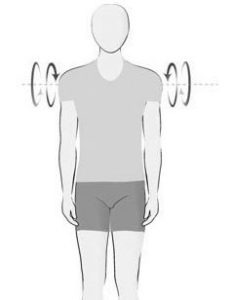
-
Arm Circles – Arm Circles improve endurance of the shoulders and arms and they also help in toning the triceps.
- Stand straight and set your feet a hip-width apart.
- Start by raising your arms and extending them out on either sides of the body parallel to the ground. Palms facing forward.
- Slowly move the arms forward following a circular pattern and continue for 8 times.
- Without putting your arms down, reverse the movement by going the opposite direction. Repeat 8 times.
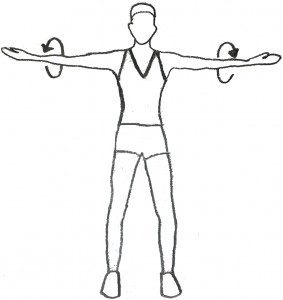
-
Standing Side Bend – Stand Side Bends focuses on stretching the obliques and abdominal muscles.
- Stand straight, put your feet together and raise both of your arms overhead with your fingers interlaced together.
- Start by slowly bending your upper body to the right without moving the hips out. Extend the stretch as far as you can.
- Once maximum range is reached, slowly bring the body back to the center and repeat the bend to the left without moving the hips out.
- Continue the motion for 8 times.
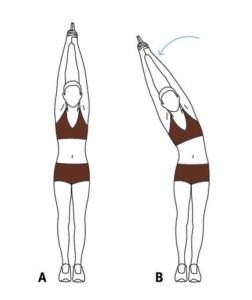
-
Hip Circles – Hip Circles are great for loosening tight muscles in the lower back and hip area as well as strengthening the core.
- Stand straight and set your feet a hip-width apart.
- Slightly bend your knees and place your hands on your hips.
- Start by slowly moving your hips in a circular but avoid extending it too far. Continue for 8 times.
- After the set, switch directions and repeat for another 8 circles.

-
Lunge with a Twist – Lunge with a Twist engages the lower body specifically the hips, glutes and legs.
- Stand straight and set your feet a hip-width apart.
- Do the lunge by stepping your left foot forward and kneeling on your right knee. Make sure both legs are bent 90-degrees and the knee of your lunging leg is behind your toes.
- Keep your back straight and put your arm across your chest and parallel to the ground.
- Slowly twist your upper body to the right as far and you can without moving your hip.
- Once maximum range of twist is reached, bring the upper body back to the center and slowly twist to the left without moving the hip. Repeat the pattern 8 times.
- Repeat the process but this time you do the lunge using the right foot. Repeat the twist for 8 times as well.
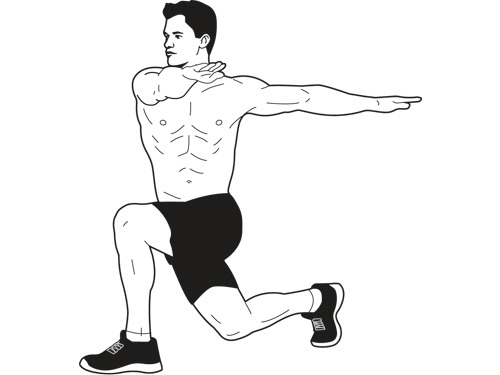
-
High Kicks – High Kicks focus on increasing flexibility in the hamstring area.
- Stand straight with your feet a hip-width apart. Slightly bend your knees.
- Start by stretching your right arm out in front of you and parallel to the ground.
- Using your left leg, kick towards your right palm as much as you can while keeping your arms and legs straight. Do the kicks for 8 times but remember to maintain controlled movements.
- Repeat the process but this time you stretch the left arm out and you kick with the right leg. Repeat the kicks for 8 times as well.
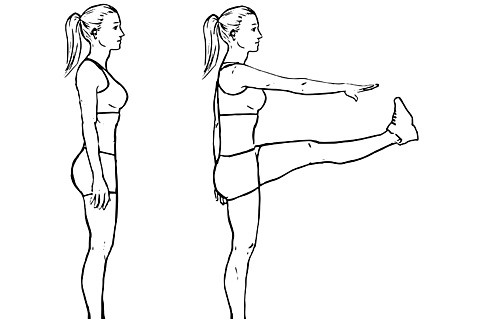
-
Hip Stretch with a Twist – Hip Stretch with a Twist focuses on the hamstring and quadriceps of the lower body but it also engages the abdominal muscles and the core.
- Start in the push up position.
- Bring your right foot forward behind the plane of the right hand.
- Slowly twist to your left while extending your left arm to the sky and perpendicular to the floor. Hold it for 2 seconds and return to the original position by bringing down your left arm first followed by your right foot back beside the other foot.
- Do the same pattern using the left foot and twisting to the right side.
- Repeat for 8 times.
-
Ankle Circles – Ankle Circles stretches the muscles and joints in the ankle allowing improvement of feet movement.
- Stand straight and set your feet a hip-width apart. Hands on your waist
- Slightly lift your one foot off the ground and slowly rotate your ankle clockwise for 8 times and counterclockwise for 8 times
- Return to initial position and do the same pattern to the other foot.

Static Stretching
What is static stretching?
Static stretching is the opposite of dynamic stretching as it involves holding the stretched muscle for a couple of seconds while staying immobile. This kind of stretching, as mentioned earlier, is done after a training or workout session to relax and cool down the body.
Generally, static stretching helps improve flexibility, increase range of motion and reduce chances of getting injuries as does dynamic stretching. But ultimately, this kind of stretching is done to relieve stress and tension in the muscles which is normal after a training session. Also, since muscles are still warm and more flexible after working out, they are easier and feel more relaxing to stretch.
Below are some of the static stretching exercises that are not only for table tennis players but also for anyone who engages in physical activities:
-
Shoulder Stretch
- Stand straight and set your feet a hip-width apart.
- Lift your right arm across your chest and parallel to the ground.
- Using your left arm, ease up your right arm closer to your chest while keeping it straight and parallel. You should feel the stretch in your shoulder.
- Hold the stretch for 16 counts and do the same to the other arm afterwards.
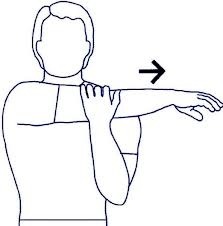
-
Triceps Stretch
- Stand straight and set your feet a hip-width apart.
- Raise your right arm overhead and bend your elbow so that your right hand is in the middle of your upper back.
- Using your left hand, slightly push your right elbow down so that you feel the stretch in the triceps more.
- Hold the position for 16 counts and do the same to the other arm afterwards.
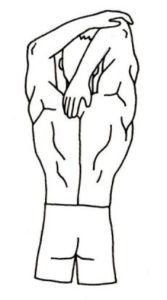
-
Groin Stretch
- Stand with your feet about a meter apart and pointing forward.
- Slowly shift your weight to your right knee while bending the same. Remember to keep your knee behind your toes and back straight. You should feel the stretch in your groins.
- Hold the position for 16 counts and switch on the other leg.
- You can increase the range of this stretch by setting your feet wider apart.

-
Abdominal Stretch
- Lie on your stomach and place your hands underneath your chest.
- Gradually lift your upper body up while keeping your pelvis on the ground.
- Hold the stretch for 16 counts.
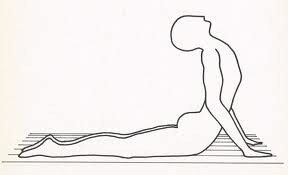
-
Hamstring Stretch
- Sit down and stretch both your legs out in front of you but avoid locking your knees.
- Keep your back straight and bend your one leg out of the way.
- Using your hands and by bending the hips, reach for the toes of the leg that is stretched out.
- Hold the stretch for 16 counts and switch to the other leg.
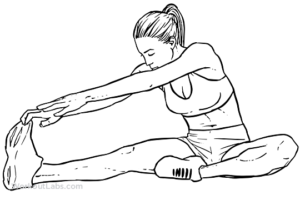
-
Quadriceps Stretch
- Stand straight and set your feet a hip-width apart.
- Using your left hand, grab your left ankle and push it toward your butt.
- Hold the stretch for 16 counts and switch to the other hand and ankle.
- If you find it hard to maintain your balance, try stretching your other hand out in front of you while doing the stretch.
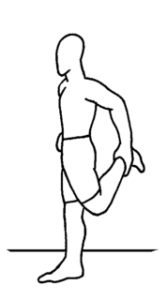
Final Reminders
- Stretching of any kind might be a bit painful for anyone who is not flexible. However, one must remember that stretching should not hurt. If you start feeling pain, then try reducing the range of the stretch so you can hold it for a couple of seconds more. The amount of time or the duration by which you are able to hold the stretch is more important than being able to stretch deep regardless if you can endure the pain.
- Bear in mind that flexibility and elasticity of the muscles are also achieved through regular practice. This is also the reason why (and in support of the first point) it is more important to be able to hold the muscles for at least 16 seconds (for static stretching). Releasing the stretch too soon is less likely to render effects on the muscles.
- Remember to not hold your breath while performing the stretch. Proper breathing helps relax muscles and reduce tension in the body which allows one to increase the stretch easier. When you breathe, blood flow is regulated throughout the body and this increases elasticity of the muscles.
- If you find it hard to maintain proper breathing while stretching, do not worry because it can come naturally through practice. Try to focus first on the breathing part and regulate it by breathing in through your nose and breathing our through your mouth. After a minute or two, slowly incorporate the stretch.
*All photos are from Google
Need more coaching advice? You can customise your table tennis coaching program with Green Paddle!
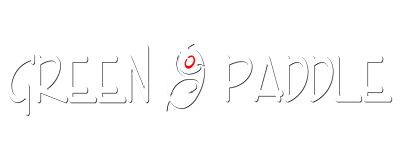
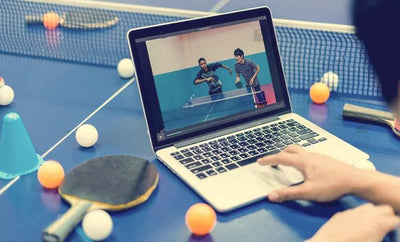


Leave a comment